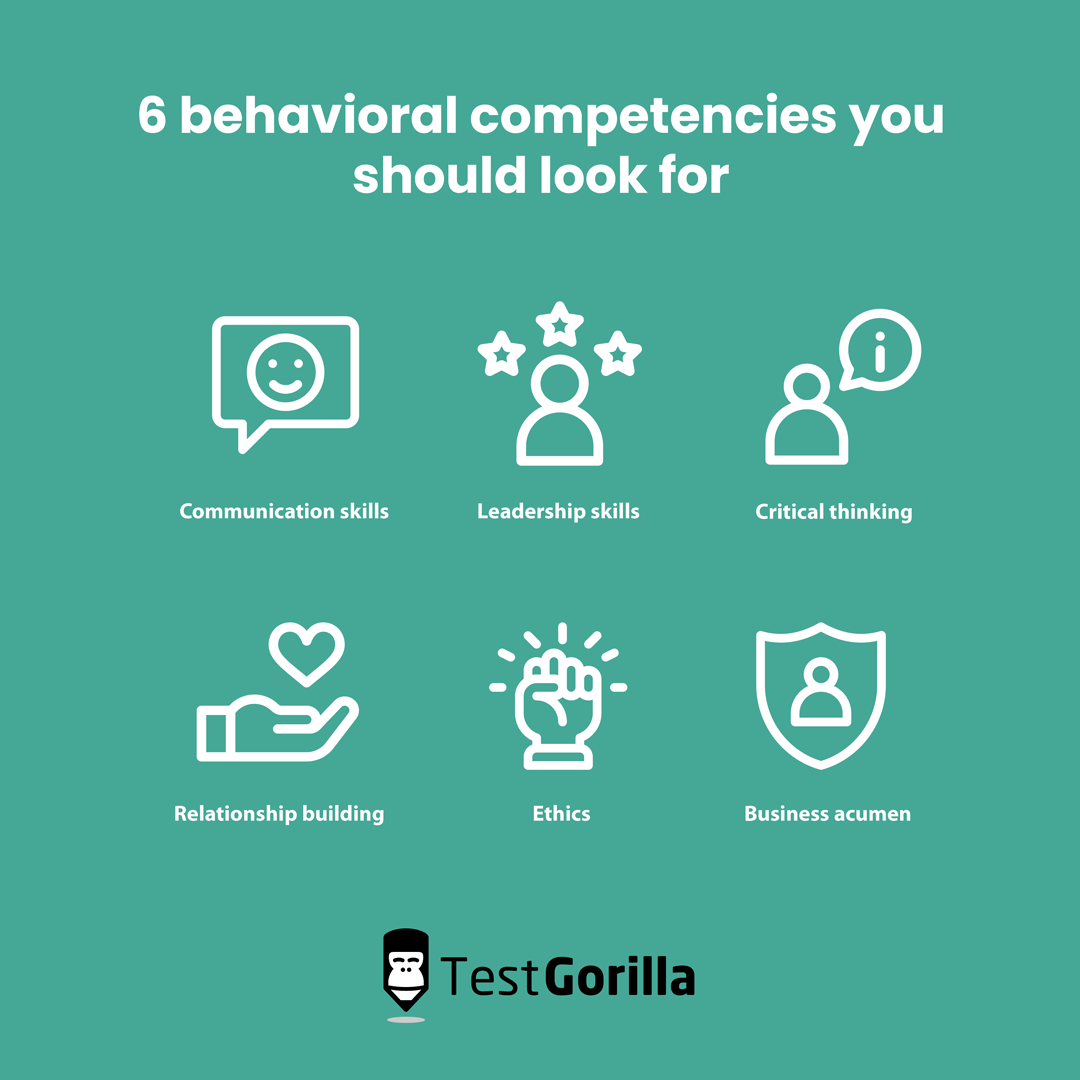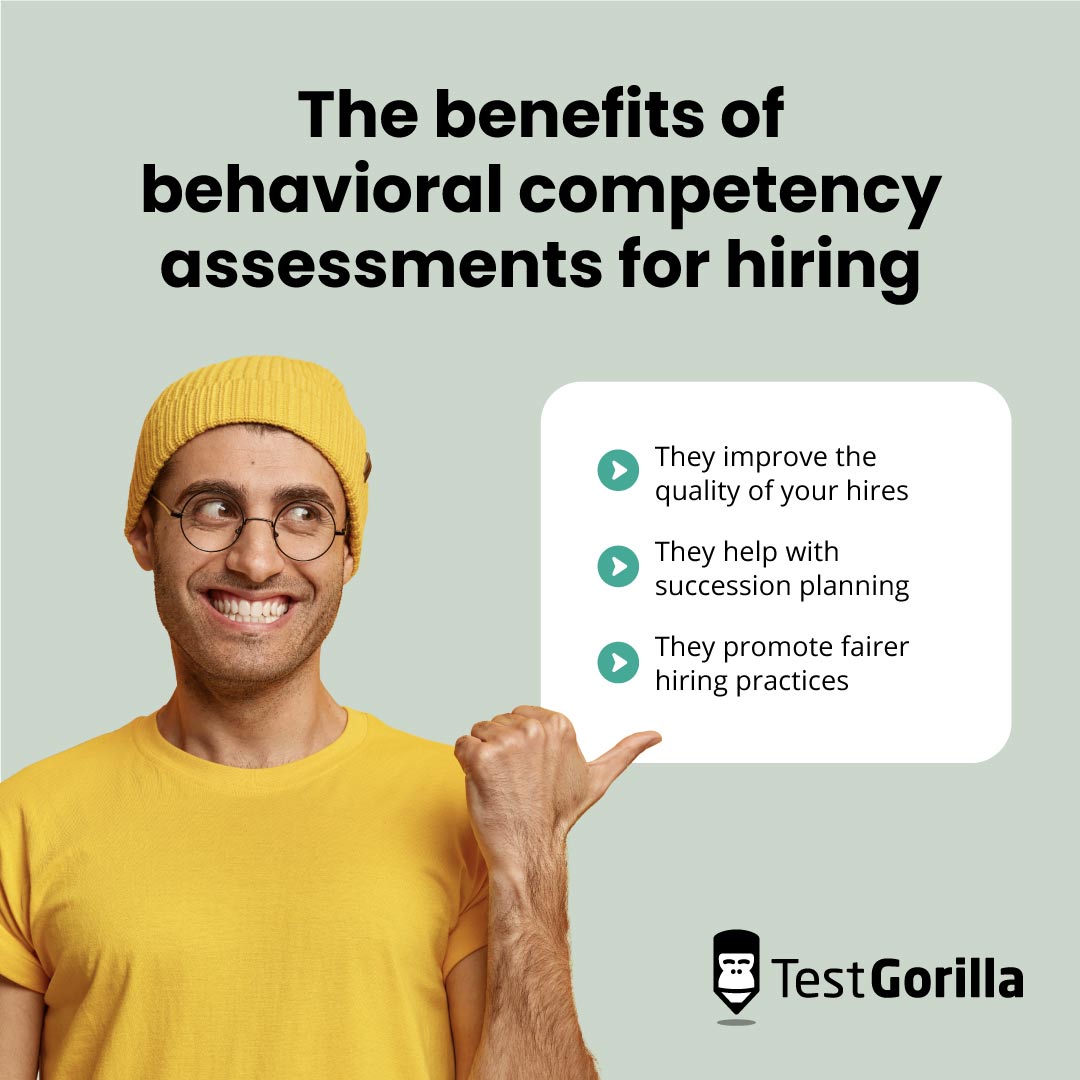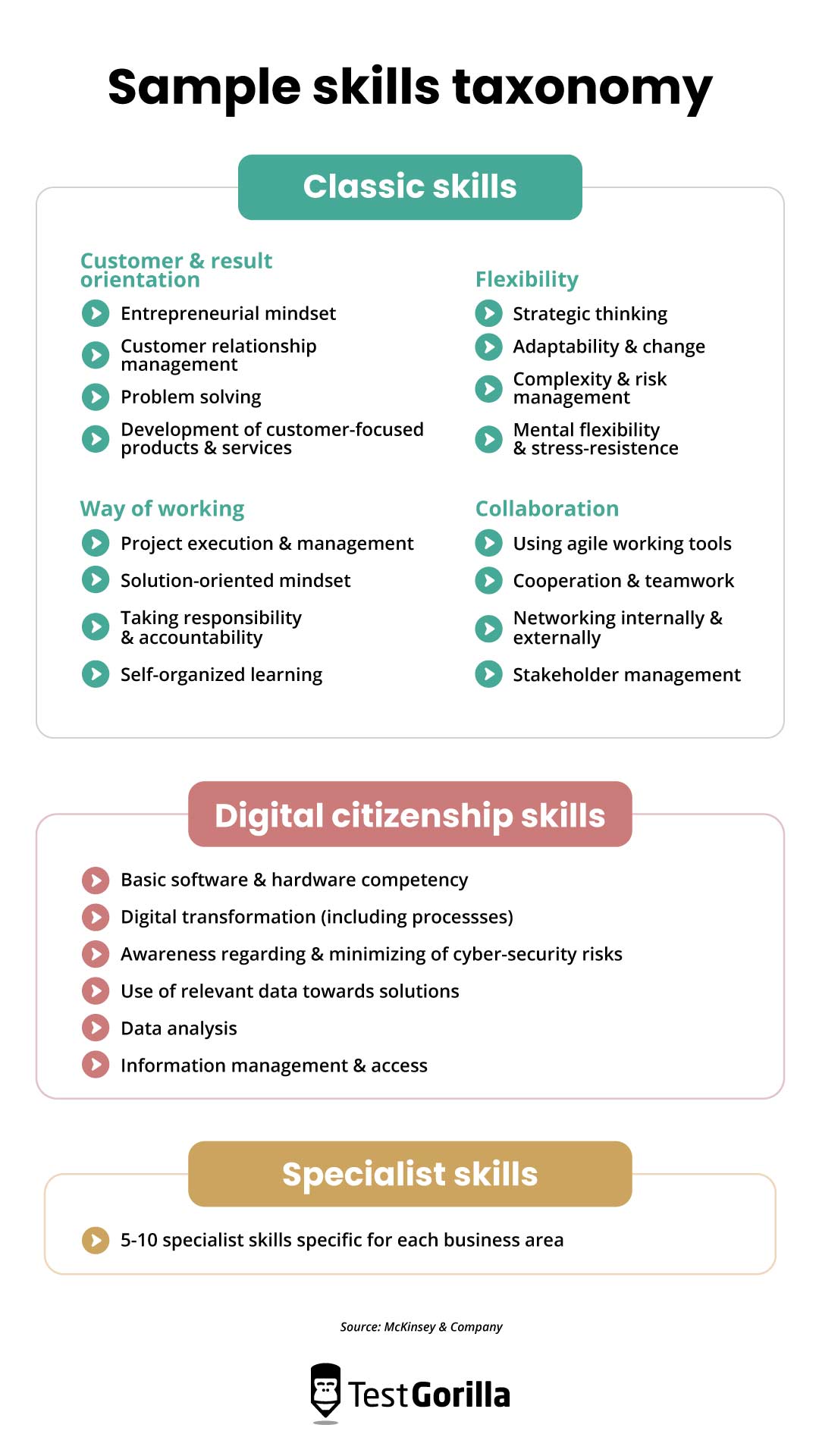We’ve all hired someone who was great on paper but a bad fit in person. Their education and experience lined up with what we were looking for, but when they started work, something felt wrong.
Chances are they were missing the behavioral competencies required to succeed in that role.
What are behavioral competencies?
Behavioral competencies are the latest talent acquisition trend to sweep recruitment, and identifying which ones apply to your open roles can help you avoid the nightmare scenario outlined above.
In fact, it’s an essential talent acquisition skill if you want to build competitive teams.
In this blog, we discuss the benefits of identifying behavioral competencies in the workplace and demonstrate how to build them into your talent acquisition strategy. We also provide examples of companies already doing it.
If you already know what a behavioral competency is, skip straight through to the best practices.
Table of contents
- What are behavioral competencies?
- Why are behavioral competencies important?
- The benefits of behavioral competency assessments for hiring
- 7 best practices for leveraging behavioral competencies to acquire top talent
- Behavioral competencies: 3 examples of companies succeeding with this talent acquisition trend
- Use skills testing to identify and assess behavioral competencies for talent acquisition
What are behavioral competencies?
Behavioral competencies are defined as the measurable traits, characteristics, and broad skills required for employees to succeed in their jobs.
There are different types of competencies. The required combination of behavioral competencies differs from company to company, but the competencies themselves are transferable across roles and industries.
This is slightly different from core competencies, which are unique to each organization and define its “edge” in the market.
The behavioral competencies definition differs from that of technical competencies; in HR, behavioral competencies usually refer to soft skills rather than hard skills.
However, some soft skills require hard skills to support them. For example, effective communication in some roles might require fluency in a specific language.
All candidates possess behavioral competencies that affect their job performance. The question you need to answer is if they have the right ones for your role.
Examples of behavioral competencies
The list of behavioral competencies examples is endless, but the six behavioral competencies in the workplace that you should look for are:
Communication skills. How employees communicate with colleagues, peers, and supervisors – whether in writing, over the phone, or face to face – is key for any role. Which specific communication competencies you require may differ between international candidates since cultures have different communication styles.
Leadership skills. Specifically, examine their leadership style: How do leaders motivate others, lead by example, demonstrate resilience, and reach goals?
Critical thinking. Your company expects your employees to be autonomous and make the best possible decisions for the organization’s wellbeing. To pull that off, your employees need critical thinking skills.
Relationship building. You need employees who know how to build relationships with others inside and outside the company. This means more than being a good communicator: It means being empathetic, giving tough feedback when necessary, and receiving feedback well.
Ethics. Your employees need to know the difference between right and wrong decisions and have the integrity to act on this knowledge. Integrity is one of the four soft skills identified by McKinsey as key to leadership.[1]
Business acumen. This means looking at the business in a holistic way, understanding how the entire organization moves and breathes in the industry and in the broader market.
These are some of the broader categories of behavioral competencies within the business domain, but they can be more specific.
For example, one study found that project manager assertiveness was one of the behavioral competencies most closely linked to success.[2]
What are examples of behavioral indicators?
Earlier, we said behavioral competencies are measurable. But how can you measure somebody’s leadership or communication style? This is where behavioral indicators come in.
Behavioral indicators are the specific, observable skills employers can test to determine the presence of a behavioral competency.
If you want to know how an employee or candidate completes a task (their behavioral competency), you should measure the skills they use to do so (their behavioral indicators).
Here are some examples:
Behavioral competencies examples | Behavioral indicators |
The ability to coach others | - Good interpersonal skills - Communication skills - Time management skills - The ability to read and interpret performance data |
Effective public speaking | - Time management skills - Presentation skills, particularly with presentation tools like PowerPoint - Confidence in speaking in front of crowds |
Teamwork | - Organizational skills – for instance, managing a team calendar - Written and verbal communication skills - Fluency in collaboration tools like Trello |
Why are behavioral competencies important?
The focus on behavioral competencies as a talent acquisition trend comes as part of the overall shift away from traditional hiring and toward skills-based hiring methods, such as pre-interview testing.
Our 2022 State of Skills-Based Hiring Report showed that more than three-quarters of organizations are using skills-based methods during recruitment, accessing benefits like reductions in time-to-hire (91.4% of organizations) and increases in diversity (91.1%).
Here’s why behavioral competency assessment brings benefits to employers and employees.
For employers
Identifying the behavioral competencies required for each role and the behavioral indicators needed to assess them enables you to better gauge employee quality.
This gives you better insight into which employees are providing the most value, and it helps you manage their performance.
This, in turn, helps with talent planning as you map out future leadership.
Not only can you determine which employees could be candidates for managerial positions, but you have a better handle on what kind of leaders you need for which departments and levels of seniority.
Finally, it helps you hire more adaptable employees. Identifying behavioral competencies helps you build roles around the broad outcome of employees’ skills (such as visionary leadership) rather than hyper-specific skill sets that are likely to change over time.
After all, nearly 60% of the workforce already needs new skills to do their jobs effectively. What employees do will inevitably change; it’s how they do it that will make a difference to your organization.
For employees
On a related note, encouraging employees to think about the way they demonstrate behavioral competencies at work instead of only their responsibilities can improve the employee experience by strengthening the sense of purpose they have in their role.
For example, you might emphasize the behavioral competency of empathetic communication to help them understand the specific value they provide to others.
It’s also more inclusive to show employees they are valued for their tangible behavioral competencies, not outmoded measures like experience or education.
Skill and competency testing gives marginalized employees, such as those from low socioeconomic backgrounds, a better chance of receiving recognition for their skills.
The benefits of behavioral competency assessments for hiring
We’ve discussed the overall benefits for employers of identifying behavioral competencies within the business domain, but here are their benefits specifically for hiring.
They improve the quality of your hires
As you might have guessed from what we’ve already discussed, paying attention to behavioral competencies in the workplace improves the quality of the candidates you evaluate.
You’re taking a holistic view of the candidate, including:
Their hard skills
Their soft skills
Their unique combination of hard and soft skills
Their mindset and the way they apply these skills in their work
By doing this, you avoid the mistake of hiring the “asshole genius,” who is gifted in their technical area but an abysmal fit for your organization.
Our State of Skills-Based Hiring report found that 92.5% of organizations experienced a reduction in mis-hires when using skills-based hiring, including testing for behavioral competencies.
You can even reduce how long it takes to hire the right candidate when you use AI in talent acquisition or recruiting automation features to streamline the process.
They help with succession planning
Succession planning is the process by which you identify important roles in your organization and line up potential employees for those roles, whether internally or externally.
It’s a key part of strategic workforce planning because it guards against leadership gaps when an important manager resigns.
In fact, Harvard researchers estimate that better succession planning could boost company valuations and investor returns by 20% to 25%.[3]
Identifying behavioral competencies in candidates helps you create a talent pipeline by recognizing people – at the start of their tenure – who have the potential to grow into leadership roles.
Using objective data from testing behavioral competencies reduces bias in succession planning. When traditional methods are used, women are less likely to be promoted than their male colleagues, despite outperforming them and being less likely to quit.
They promote fairer hiring practices
Focusing on behavioral competencies over outdated criteria – like four-year degrees – also enables you to open your recruitment process to more diverse candidates.
This includes STARS – employees skilled through alternative routes.
As we mentioned above, 91.1% of organizations saw an increase in diversity after switching to inclusive hiring practices like skills-based hiring methods.
This also applies to internal hiring. Identifying behavioral competencies helps you spot employees with useful adjacent skills who could be moved into cross-functional roles.
It also shows you who in your workforce has the skills most vital to organizational success instead of simply promoting the person with the best technical skills.
Finally, skills testing provides a foundation of data for decision-making, reducing bias's impact on internal and external hiring.
One study of more than 2,000 successful job placements found that the number of women hired into senior roles increased by 70% when skills-based methods were used.
7 best practices for leveraging behavioral competencies to acquire top talent
Now that we’ve covered the benefits of identifying behavioral competencies in the workplace, you need to know how to do it. Here are seven best practices to get started.
7 best practices for using behavioral competencies in the workplace: Summary table
Already have a strong foundation in using skills-based methods and ready for the next step?
Here’s a quick summary:
Best practice for using behavioral competencies in hiring | Important actions |
1. Identify behavioral competencies for your organization | Use department-level surveys or brainstorming sessions to understand employees’ views of your company mission and how this impacts their work |
2. Assess your current employees to identify behavioral indicators | Assess high-performing teams using personality trait tests like the DISC test to understand their behavioral indicators |
3. Streamline your processes by creating a skills taxonomy | Refer to skills test data, industry benchmarks, and interviews and consultations with industry experts to generate a list of essential skills for your organization |
4. Use talent assessments to identify behavioral indicators in candidates | Use your understanding of behavioral competencies to shape your job description and use skills testing to screen candidates |
5. Use job simulations to see behavioral competencies in action | Test candidates on a specific task they would perform daily in their target role – for example, a coding task |
6. Conduct structured interviews to assess behavioral competencies | Ask all candidates the same questions, in the same order, judged by the same criteria |
7. Design professional development plans to strengthen behavioral competencies | Craft flexible professional development plans targeting behavioral competencies instead of specific skills |
1. Identify behavioral competencies for your organization
The first step to leveraging behavioral competencies at work is figuring out what the most important ones are for your organization as a whole. This is especially important for leadership and management roles.
To do this, you need to understand your organizational culture. Specifically, you need to understand:
What unites your employees
What motivates them
What they see as their common purpose
This last point is particularly important.
Around four in 10 American workers view their job or career as essential to their overall identity.[4]
Understanding these factors gives you insight into your key behavioral competencies by showing you how your overall mission impacts employees and their jobs.
For example, if you’re an organization with a strong focus on innovation, a key behavioral competency across your organization would be thinking outside the box.
This might differ from an organization that prioritizes sustainability, where simplifying processes to maximize efficiency would be more important.
You could gather this information with department-level surveys or brainstorming sessions with employees.
2. Assess your current employees to identify behavioral indicators
Once you’ve identified the key behavioral competencies at different levels of your organization, you can verify these hypotheses using talent assessment tests.
Then you can create a competency framework necessary for successful employee performance in your specific work environment.
The behavioral indicators for some of these competencies might be fairly obvious.
For example, you know communication-based competencies require communication skills. Depending on the role, you could break this down further into written or verbal communication skills.
To determine other behavioral indicators, administer personality tests like the DISC test or Big 5 (OCEAN) test to high-performing teams to understand how they work.
3. Streamline your processes by creating a skills taxonomy
Using this combined information, create an overall skills taxonomy to reference while hiring for any role.
Refer to multiple sources for this, including:
Skills test data
Industry benchmarks and data
Interviews and consultations with industry experts
Most importantly, ensure each skill you identify is attached to a behavioral competency and vice versa. You need to have a plan for measuring each competency you value in your business.
Creating an effective skills taxonomy helps you generate an ideal candidate profile, or ICP, for each role you recruit for.
This forms a fundamental resource for hiring managers to refer to when hiring for any role at your organization.
4. Use talent assessments to identify behavioral indicators in candidates
Now it’s time to apply this knowledge to your hiring plan for a specific upcoming role.
First, use your understanding of behavioral competencies to inform your recruitment marketing and how you frame the role as part of your overall corporate identity.
Next, screen applicants using skills tests instead of outdated measures like resumes and four-year degree requirements. As we’ve discussed, this opens the field to more diverse candidates and gives them a fairer chance of being seen by your hiring team.
Skills testing also empowers you to objectively rank candidates’ performance in key skill areas rather than relying on a potential new hire’s self-assessment of their specific competencies.
Further, tools like TestGorilla’s sophisticated talent acquisition analytics make it easier to compare pools of candidates.
5. Use job simulations to see behavioral competencies in action
Not all behavioral competencies will be totally clear from a skills test targeting employees’ behavioral indicators; sometimes, you need more qualitative evidence.
This is where you should use job simulations. A job simulation is when you test candidates on a specific task they would perform on a daily basis in their target role.
Thanks to updated talent acquisition technology, this can be administered as part of a skills test – such as giving candidates a coding exercise as part of their assessment.
Job simulations can be offered at the screening stage with situational judgment questions and work samples.
They can also be used later in the process. For example, a test might show a customer service candidate has great communication skills, but you want to see if they nail the empathetic tone that’s central to your company brand.
In this instance, you could give shortlisted candidates a take-home assignment, asking them to answer an email or multiple emails from customers. You could then instruct hiring managers to blindly rank their responses.
6. Conduct structured interviews to assess behavioral competencies
Talent assessments support data driven recruiting at the screening stage, but you can also bring this objectivity into interviews by using a structured interview approach.
Unlike traditional unstructured interviews, which are mostly improvised and unfold like a normal conversation, structured interviews require interviewers to ask all candidates:
The same questions
In the same order
Judged by the same criteria
This ensures all candidates are assessed on the same skills, avoiding any tangents because the interviewer and candidate “get on really well.” It also streamlines decision-making after interviews.
For the best results, include situational and behavioral interview questions, such as:
What’s your strategy for making an excellent first impression on a client?
Explain your biggest work failure. How did you handle it?
How would you motivate other team members?
This enables you to directly and qualitatively compare candidates’ behavioral competencies in addition to the harder data you already have.
7. Design professional development plans to strengthen behavioral competencies
Finally, use your knowledge of behavioral competencies to design better continuous learning and development initiatives for employees.
Instead of simply building on the specific skills employees already have, create flexible professional development plans that address the overall behavioral competencies of their role.
This gives employees autonomy over which skills they develop and freedom to adjust their careers – all while keeping them on track to deliver the organization’s desired outcomes. And you can start this early during new employee onboarding.
Crafting professional development plans for employees improves internal mobility by promoting skill growth so employees can access more roles and promotions.
It also improves employees’ relationships with your company.
The number one reason people leave their jobs is a lack of learning and development opportunities.
This positive experience is important. If employees do leave, they are more likely to return as boomerang employees if they have strong social ties within your organization.
In addition to tempting back former employees, upskilling programs have also been proven to increase productivity, talent acquisition and retention, and resilience in the workforce.
Behavioral competencies: 3 examples of companies succeeding with this talent acquisition trend
What is behavioral competency identification’s value in different industries?
To help you understand how identifying behavioral competencies in the workplace can benefit different types of companies, we’ve put together three examples from across sectors.
3 examples of companies succeeding with the behavioral competency model: Summary table
Strapped for time? Here’s a quick summary
Company using behavioral competency assessments | Summary |
LG | Identified the ideal behavioral competencies for leaders and created a dedicated leadership academy to bring all current and future leaders in line with this behavioral competency model. |
Devereux Cleo Wallace | Outlined the desired behavioral competencies for workers at a high-churn office and implemented a competency-based selection process. This reduced turnover from 60% to 15%-20%. |
Chandler Macleod | Uses skills testing to create a behavioral competency overview for each candidate. The agency then uses this to match temporary employees with potential employers. The company reports employees matched this way are more effective and last longer in their roles. |
LG (consumer electronics)
LG, the consumer electronics retailer, identified its ideal behavioral competency model for leaders and realized that the leadership competencies shown in the organization deviated widely from this framework.
Leaders then translated the desired behavioral competency model into behavioral descriptors that were used to assess and train leaders through the LG Leadership Academy.
This brought all leaders back onto the same page and laid the foundation for future leadership development.[5]
Devereux Cleo Wallace (healthcare)
Devereux Cleo Wallace, a healthcare organization in Westminster, Colorado, was dealing with a retention problem.
Turnover rates were 60% at one of its sites, suggesting a poor fit between employees and their roles.
After implementing a competency-based selection process, the formerly high-churn plant saw turnover fall to between 15% and 20%, a significant improvement.[6]
Chandler Macleod (recruitment)
Chandler Macleod, a recruitment agency, applies its understanding of behavioral competencies within the business domain to help match temporary employees with open roles.
The company uses skills testing to inform “competency overviews” that demonstrate the match potential between a temp and a target company.
It says this method makes recruits more effective and longer-lasting in their roles.
Use skills testing to identify and assess behavioral competencies for talent acquisition
There are many applications for behavioral competencies within the business domain, from improving learning and development initiatives to optimizing hiring.
Perhaps most importantly, understanding your employees’ behavioral competencies helps you strengthen their understanding of your organizational values and create a stronger sense of purpose in their work.
To find out more about promoting a mission-driven workforce, read our blog about how skills-based hiring builds a culture of belonging.
For more ideas about supercharging your hiring, read our rundown of the latest talent acquisition strategies.
Or, if you’re ready to start using behavioral competencies assessments, use our Problem Solving test to hire the best.
Sources
Ritter, Ron; Ruggero, Ed. (October 2, 2017). “Leadership in innovation needs innovation in leadership”. McKinsey & Company. Retrieved August 18, 2023. https://www.mckinsey.com/capabilities/operations/our-insights/leadership-in-innovation-needs-innovation-in-leadership
Gruden, Nika; Stare, Aljaz. (June 2018). “The Influence of Behavioral Competencies on Project Performance”. Project Management Journal. Retrieved August 18, 2023. https://www.researchgate.net/publication/326137973_The_Influence_of_Behavioral_Competencies_on_Project_Performance
Fernández-Aráoz, Claudio; Nagel, Gregory; Green, Carrie. (May 2021). “The High Cost of Poor Succession Planning”. Harvard Business Review. Retrieved August 18, 2023. https://hbr.org/2021/05/the-high-cost-of-poor-succession-planning
Menasce Horowitz, Juliana; Parker, Kim. (March 30, 2023). “How Americans View Their Jobs”. Pew Research. Retrieved August 18, 2023. https://www.pewresearch.org/social-trends/2023/03/30/how-americans-view-their-jobs/
Wilson Burns, Erin; Smith, Laurence; Ulrich, Dave. (2012). “Competency Models With Impact: Research Findings From the Top Companies for Leaders”. The RBL Group White Paper Series. Retrieved August 18, 2023. http://rblip.s3.amazonaws.com/Articles/Competency%20Models%20with%20Impact.pdf
Katz, Lee Michael. (January 29, 2015). “Competencies Hold the Key to Better Hiring”. Society for Human Resource Management. Retrieved August 18, 2023. https://www.shrm.org/hr-today/news/hr-magazine/pages/0315-competencies-hiring.aspx
Related posts
Hire the best candidates with TestGorilla
Create pre-employment assessments in minutes to screen candidates, save time, and hire the best talent.
Latest posts
The best advice in pre-employment testing, in your inbox.
No spam. Unsubscribe at any time.

Hire the best. No bias. No stress.
Our screening tests identify the best candidates and make your hiring decisions faster, easier, and bias-free.
Free resources
This checklist covers key features you should look for when choosing a skills testing platform
This resource will help you develop an onboarding checklist for new hires.
How to assess your candidates' attention to detail.
Learn how to get human resources certified through HRCI or SHRM.
Learn how you can improve the level of talent at your company.
Learn how CapitalT reduced hiring bias with online skills assessments.
Learn how to make the resume process more efficient and more effective.
Improve your hiring strategy with these 7 critical recruitment metrics.
Learn how Sukhi decreased time spent reviewing resumes by 83%!
Hire more efficiently with these hacks that 99% of recruiters aren't using.
Make a business case for diversity and inclusion initiatives with this data.






















